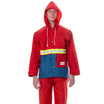Safety at the workplace should never be considered lightly, especially when the work environment is riddled with potential hazards. It doesn't matter whether you work in a bustling factory, in the bowels of a mine, or are surrounded by dangerous chemicals in a laboratory - knowing how to recognize potential threats and take the necessary precautions can go a long way in ensuring your wellbeing and the wellbeing of others around you.
In this article, we'll explore a range of hazardous environments, observing their distinguishing characteristics and risks involved. Our journey will underscore the utmost importance of safety in these environments, elucidating how this commitment to safety extends beyond preventing accidents and injuries, and is instrumental in promoting worker health, longevity, and business continuity.
Moving further, we dive deep into the essential safety tips any modern worker should have in his toolkit. From the proper use of Personal Protective Equipment to the importance of emergency preparedness and response, we'll provide insight and practical advice.
Finally, we'll help you navigate the complex world of workplace safety standards and regulations — breaking down important legislation and standards like the Occupational Safety and Health Act (OSHA), the Mine Health and Safety Act, and more.
Get ready to embark on this deep dive into workplace safety, because knowledge is not just power, but in hazardous work environments—it’s protection.
Identifying Hazardous Environments
The ability to pinpoint potentially risky situations in our surroundings is an essential skill we all should acquire, especially in the workplace. This section will embark on an enlightening expedition that aims to illustrate the different types of hazardous environments you might encounter, namely: chemical, physical, biological, and ergonomic dangers.
Chemical Hazards
Chemicals, while integral to many working processes, can pose significant risks if mishandled or incorrectly stored. Let's peel back the veil on this type of hazard:
- Nature: Chemical hazards revolve around substances that can potentially cause harm through skin contact, ingestion, inhalation, or eye contact. They appear in different forms, stretching from liquids to gases, solids, and even dust.
- Examples: These include substances like acids, solvents, disinfectants, paints, flammable materials, or even the seemingly innocent office copier toner.
- Safety Tips: The best practice for managing chemical hazards entails using personal protective equipment (PPE), proper storage, employee training, and adequate workplace ventilation.
Physical Hazards
Physical hazards, a common type among hazardous environments, often hide in plain sight. Here's a breakdown of these safety risks:
- Nature: These dangers stem from factors in the environment that can cause physical harm. Examples range from extreme temperatures to noise, radiation, and incorrect settings on machinery.
- Examples: Physical hazards might be as extreme as unguarded machines or as subtle as recurrent loud noises that affect hearing over time.
- Safety Tips: Mitigating physical hazards often involves maintaining machinery regularly, employee training, implementing safety procedures, and using proper protective gear.
Biological Hazards
The invisible nature of biological threats contributes significantly to their danger. Take a glimpse into the world of these unseen hazards:
- Nature: Biological hazards present themselves as bacteria, viruses, fungi, and other microorganisms that can pose health risks to humans.
- Examples: Examples run from mold growth in a damp workplace to exposure to human blood or other potentially infectious materials.
- Safety Tips: Implementing proper hygiene practices, providing immunizations where necessary, and monitoring conditions that promote microbial growth are effective ways to control biological hazards.
Ergonomic Hazards
Last but not least, ergonomic hazards often fly under the radar, attributed to poor-work related conditions. Let's delve into this dangerous territory:
- Nature: These dangers root from strained physical positions, repetitive movements, incorrect workplace setup, and the overuse of certain muscles.
- Examples: An example could be an office worker suffering from carpal tunnel syndrome due to constant typing.
- Safety Tips: Periodic breaks, proper workplace arrangement and the use of ergonomically correct furniture and equipment helps in warding off these threats.
Identifying hazardous environments correctly can potentially avert disasters before they strike. As we journey through the different types of hazards, we learn that managing risks begins with recognizing their presences and understanding their nature. This knowledge serves as our first line of defense in ensuring our workplaces are as safe as possible.
Importance of Safety in Hazardous Environments
Working in hazardous environments exposes employees to numerous life-threatening risks. Jobs that require interaction with heavy machinery, toxic substances, or dangerous heights come with their unique challenges. Ensuring safety in such workplaces is not just the legal, but also the moral obligation of employers. By making safety a priority, industries can provide safe and healthy workspaces, safeguard workers, and ensure business continuity.
Preventing Accidents and Injuries
One significant advantage of prioritizing safety in hazardous environments is the prevention of accidents and injuries. To ensure this:
- Regular safety training should be provided to educate employees about potential risks and how to respond accordingly.
- Safety gear and equipment must be distributed in settings where there are risks of physical injuries.
- Frequent inspections and audits should be performed to identify potential hazards and offer suitable corrective measures.
Businesses should actively work towards eliminating any foreseeable hazards that could potentially lead to accidents.
Promoting Worker Health and Longevity
A safe environment promotes both physical health and psychological well-being. When workers realize that their safety is taken seriously, they will likely feel less stressed, leading to improved productivity and quality of work. Here’s how it can be achieved:
- Ensuring machinery and equipment do not emit harmful pollutants can prevent long-term health problems like respiratory illnesses.
- Providing adequate breaks can prevent worker fatigue and possible strain injuries.
- Maintaining a clean and well-organized workplace can reduce the risk of health complications, such as infections or illnesses resulting from unhygienic conditions.
With a robust safety plan, employee turnover and absenteeism rates could also see a considerable decline, proving beneficial to the overall productivity and profitability of the company.
Ensuring Business Continuity
Safety concerns are potential disruptors to business operations. By prioritizing safety, businesses are actually ensuring their own continuity. The fallout from a severe accident can be monumental, leading not just to financial loss, but it can also severely harm the business's reputation.
Casualties could result in lawsuits that can be economically draining for businesses, while major accidents could even lead to shutdowns until investigations are completed and necessary changes are made. To avoid such disruptions, creating a safe working environment is essential.
By enforcing safety measures, businesses protect themselves from potential operational and financial hazards. In essence, an investment in safety is an investment in the future sustainability of the organization.
Essential Safety Tips
In the interconnected world of today, safety has never been more crucial. One sector that particularly stands out when it comes to safety's indispensability is the construction industry. And while the industry has seen a wide range of advancements in ensuring worker safety, it is still necessary for individuals to keep in mind fundamental safety hacks.
Proper Use of Personal Protective Equipment
It's said that defense is the best offense; this definitely rings true in the construction environment. Personal Protective Equipment (PPE) such as hard hats, safety glasses, and construction boots are your first line of defense against common work hazards. For those working in adverse weather conditions like rain, additional gear may be required. For example, improved rain gear offers a dual purpose: providing protection against harsh weather while ensuring the worker's visibility, thus further enhancing safety (Revolutionizing Safety with Rain Gear).
Regular Equipment Safety Checks
To ensure safety, it is important to regularly inspect your equipment and tools. This minimizes the risk of malfunctioning or broken gear causing accidents. From measuring tapes to heavy machinery, every tool should be kept in optimum condition.
Effective Communication and Training
Communication is key, not just in relationships, but also on the worksite. Clear instructions, discussions about potential risks, and training on new equipment can help prevent accidents. Remember that being aware of issues is the first step to addressing them.
Emergency Preparedness and Response
Even with all the precautions, emergencies can still occur. It's critical to prepare an effective response plan for accidents, natural disasters, and other unexpected events. Cast the net wide — the plan should consider everyone, from the onsite workers to the passersby.
Proper Waste Disposal
The sustainability wave has hit the construction industry as well. Eco-friendly practices, such as proper waste disposal, can ensure the safe and clean functioning of a site. Remember, a clean site is a safe site!
Regular Health Checks
A strong structure requires a strong foundation. Same goes for the workers — a regular health check ensures the well-being of the workforce, further solidifying the safety foundations of the construction site.
Implementing Breaks and Rest Periods
Last but not least, never underestimate the power of a break. Regular rest periods can help keep the workers refreshed and alert. After all, a well-rested workforce can be a game-changer in maintaining safety standards.
Safety should not be an option but a priority. These essential tips must serve as a guiding light for all individuals in the construction industry — from seasoned professionals to greenhorns. Now, let's take a step forward toward a safer, healthier working environment!
Workplace Safety Standards and Regulations
When it comes to ensuring a safe working environment, there's a gamut of regulations and standards to abide by in different industries. Understanding them can be overwhelming, but these rules serve a vital function: to safeguard workers' health and wellbeing. Here's a closer look at some of the most important safety standards applicable to various industries.
Occupational Safety and Health Act (OSHA)
First and foremost, there's the Occupational Safety and Health Act, widely known as OSHA. Enacted in 1970, this legislation is intended to guarantee safe and healthy working conditions for working men and women. It mandates employers to implement workplace safety and health standards to protect their employees from any hazardous and harmful situations.
OSHA standards cover a broad spectrum of workplace safety issues, including:
- Machinery and Equipment Safety
- Occupational Noise Exposure
- Electrical Safety Standards
- Emergency Response Plans
- Bloodborne Pathogens Protections
Mine Health and Safety Act
Another critical measure for safety is the Mine Health and Safety Act, which specifically caters to the unique requirements of the mining industry. This Act enforces rigorous worker safety standards on mine operators, with regulations focused on:
- Minimizing the risk of mining accidents
- Use of safety gear and machinery in mines
- Procedures for handling explosives
- Monitoring air quality in mines
Workplace Hazardous Materials Information System (WHMIS)
For those industries dealing with hazardous materials, the Workplace Hazardous Materials Information System (WHMIS) is an indispensable resource. This comprehensive system provides information on the safe usage, storage, and disposal of hazardous materials, enabling workers to manage these materials without risking their health and safety.
National Fire Protection Association (NFPA) Regulations
When it comes to fire safety, the National Fire Protection Association (NFPA) sets the bar. The NFPA develops and updates fire safety standards and codes, providing guidelines for fire prevention and emergency response. With standards like NFPA 101 for Life Safety and NFPA 70 for the National Electrical Code, the NFPA is instrumental in maintaining a fire-safe working environment.
Remember, the key to a safe workplace lies in understanding these regulations and implementing them effectively. Regular training, frequent safety audits, and continuous conversations about safety can help foster a culture where safety standards are respected and observed. Compliance with these regulations isn't just about avoiding penalties, it’s about safeguarding the health and wellbeing of all employees, which is, and should always be, a top priority.
Conclusion
As we draw this discussion to a close, we've established that safety in hazardous environments is paramount. By recognizing potential hazards, implementing proper safety measures, complying with workplace safety standards and regulations, we can create a safer workspace. Remember, the importance here is not just avoiding injuries or accidents, but fostering a culture of safety where every worker feels valued and protected.
At this point, it's worth noting that a significant part of safety in hazardous work environments involves using the right personal protective equipment. Canadian-made and designed to withstand harsh conditions, the chainsaw safety pants from Rain Gear Pro offer superior protection and comfort, making it a worthwhile investment for those facing challenging work conditions.
Remember, promoting safety in hazardous environments is everyone's responsibility – from the management to the employees. Ensure you're doing your part to contribute to a safer, healthier workspace. With the right procedures, equipment and mindset, every workday can be a safe workday.
Frequently Asked Questions
-
What are some general safety tips for working in hazardous environments?
Some general safety tips for working in hazardous environments include: wearing appropriate personal protective equipment (PPE), receiving proper training and certification, following safety procedures and protocols, regularly inspecting and maintaining equipment, practicing good housekeeping, and reporting any safety concerns or incidents.
-
What is the importance of risk assessment in hazardous environments?
Performing a risk assessment is crucial in hazardous environments as it helps identify potential hazards and evaluates the level of risk associated with each hazard. This allows employers and workers to implement necessary control measures to mitigate risks and ensure a safer working environment.
-
What are some common types of personal protective equipment (PPE) used in hazardous environments?
Common types of personal protective equipment (PPE) used in hazardous environments include: safety helmets, goggles or safety glasses, hearing protection, respirators or masks, gloves, safety footwear, and high-visibility clothing.
-
How often should equipment be inspected in hazardous environments?
Equipment in hazardous environments should be regularly inspected according to manufacturer guidelines and industry standards. The frequency of inspections may vary depending on the type of equipment and the specific workplace hazards, but it's generally recommended to have a routine inspection schedule in place.
-
What should I do if I encounter a safety concern or incident in a hazardous environment?
If you encounter a safety concern or incident in a hazardous environment, the first step is to report it immediately to your supervisor or safety officer. Follow any emergency procedures that have been established and cooperate with investigations to identify the cause and prevent future incidents.


















Leave a comment
This site is protected by hCaptcha and the hCaptcha Privacy Policy and Terms of Service apply.